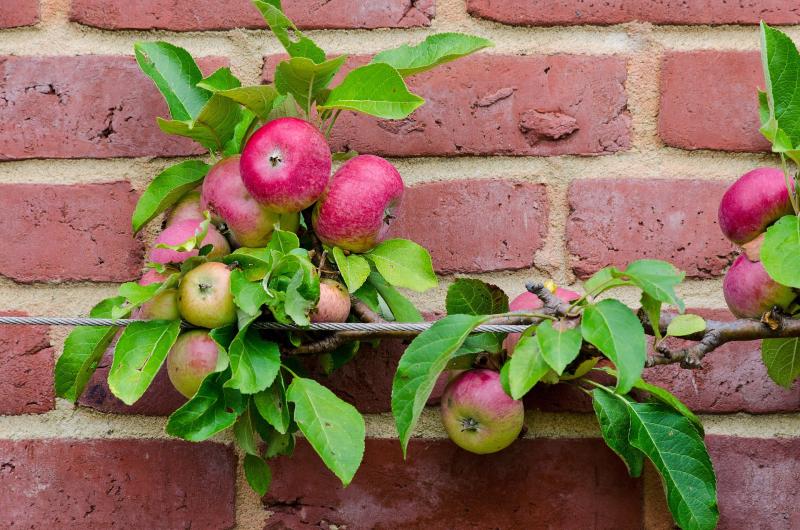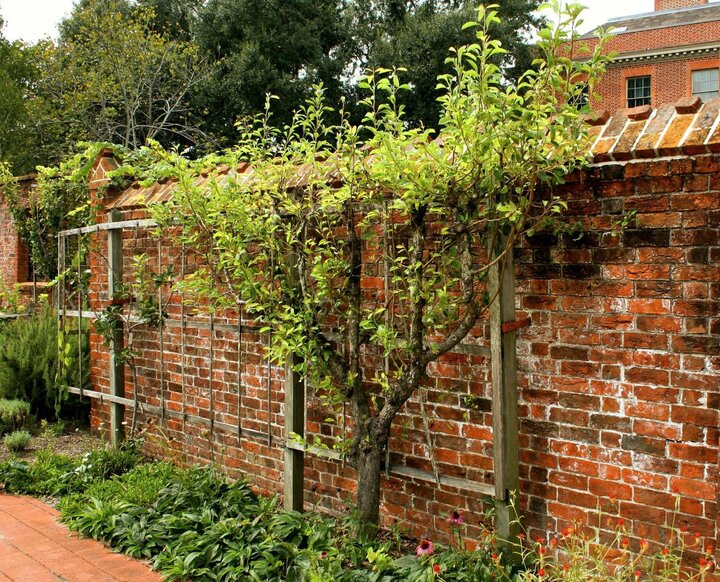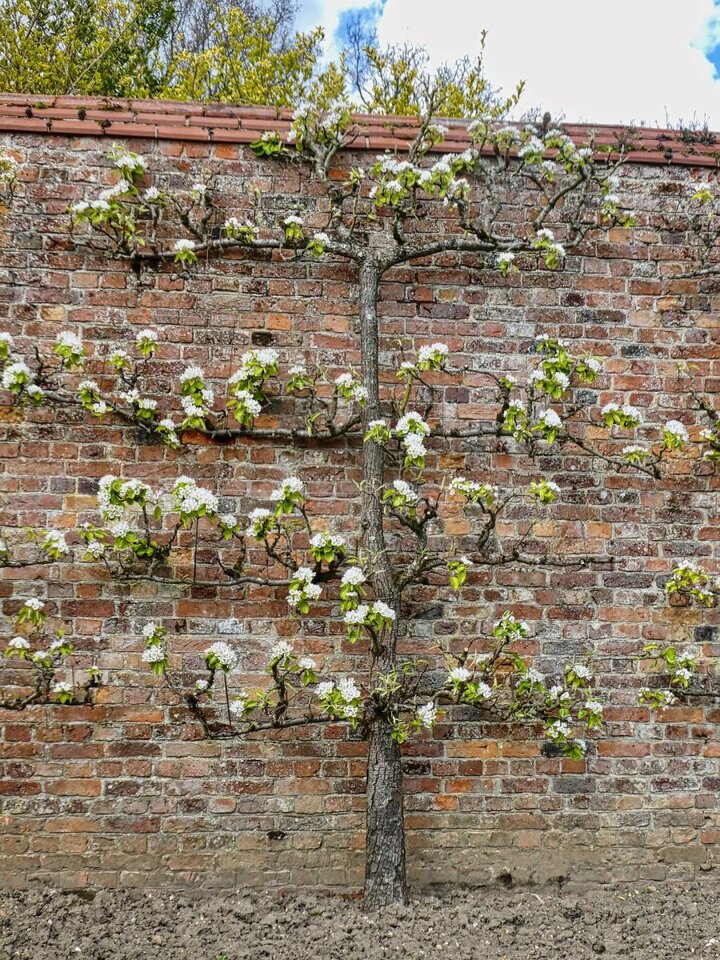Sarah Browning, Nebraska Extension Educator

Close up of apple branch trained on an espalier structure with wire arms. Images from Pixabay.
An old horticulture practice of controlling plant growth in a flat plane against a solid surface or trellis has merit in today’s smaller landscapes. This is the art of espalier, pronounced ess-PAL-yer, or ess-PAL-yay. The word espalier is French, but is derived from the Italian word spalliera meaning “something to rest the shoulder against.” The technique of espalier is not the same as that of topiary, which creates a free-standing, 3-dimensional plant pruned to a decorative shape. Espaliered plants have only two dimensions, height and width, and most commonly have a support structure. Freestanding espalier is much less common.
The practice of espalier was used in the old world to conserve space in small orchards and gardens. George Washington’s kitchen garden at Mount Vernon featured espaliered peach and apricot trees. But this garden art form goes back much farther in history. Espalier was practiced in the gardens of Egyptian Pharoahs, by monks in the middle ages, and in the gardens of French Kings.

Espalier as a Landscape Feature
Today, espalier is used for fruit production, but also to create decorative elements in the landscape. As a landscape feature, an espaliered plant can be a focal point or living sculpture in the garden, or it can fulfill a function as a screen or backdrop. Espaliered plants are beautiful against blank walls or fences where their unique form softens the wall. They are a much more interesting and unusual alternative to a typical shrub grouping. Espaliered plants are also a great alternative in tight, confined areas where wide spreading shrubs or trees won’t work.
Since espalier fruit trees grow in a smaller space, it allows the gardener to experiment with more cultivars and improve flower pollination. Fruit trees trained as espalier make disease and insect control easier. Pruning improves air circulation around the foliage reducing disease problems. And since trees are pruned to a manageable size, pesticide applications and harvesting are easier too.
If you’re having trouble envisioning an espaliered plant, think of grape vines. The training systems used by commercial grape growers are a form of espalier. For grapes, a commonly used trellis system has three or more wire “arms”, or cordons, along which the vines are trained.
But the form and decorative nature of an espalier training system is only limited by your imagination. Some common training patterns include plants with multiple levels of horizontal arms called tiers; a fan, candelabra, or chevron shape; or the more intricate basket weave or diamond patterns.
Choosing Plant Material
Espaliers can be created with many types of woody trees and shrubs, just look for plants with long, flexible branches. Where space permits, trees such as saucer magnolia; crabapple; Amur, Miyabe or Trident maple; and ornamental pear can be used with success. Fruit trees including spur-type apple and pear cultivars, plum and peach can be used. Although less common, cherries can also be grown as espalier.
But keep in mind trees require a large surface for their support system, and for them to cover and grow. Smaller plants that make excellent espaliers include althea, pyracantha, flowering quince, juniper, and viburnum.
The mature size of the plant chosen will dictate plant spacing. Choose fruit tree cultivars with dwarfing rootstocks. The secret of satisfactory espaliering is to begin with a young tree or shrub that has several well-balanced limbs off the main trunk.

Creating Your Espalier
From a design standpoint, espalier plants are a unique landscape focal point and should not be overused. One espalier would be sufficient for a small house and landscape.
Consider the best location in your landscape and the desired mature plant shape. Once established an espalier will require pruning and maintenance throughout the year, so make sure you understand the work involved. A well-maintained espalier is a beautiful garden achievement, but a poorly maintained espalier is an eye-sore. Make sure any support structure or trellis system is within easy reach for maintenance practices.
If you’re intrigued by the idea of espalier, check out these resources to understand the pruning and training techniques used to create and maintain it.
- Trained Trees Lend Structural Elegance to Garden, Fine Gardening.
- Pruning and Training: The Definitive Guide to Pruning Trees, Shrubs and Climbers, from The American Horticultural Society by Christopher Brickell and David Joyce, 2011. Note: Look for this resource at bookstores, or order online.
Images from Pixabay.com.
- Fruit tree espalier trained on a wooden support structure.
- Fruit tree espalier trained against a brick wall.